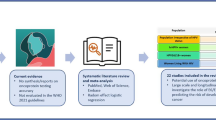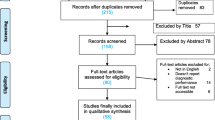Abstract
Gains of 3q26 chromosome region, where the human telomerase RNA gene (hTERC) is located, have been previously documented in cervical carcinomas. However, published data on this subject are inconclusive. Therefore, we performed a meta-analysis to evaluate the diagnostic value of hTERC in high-grade cervical lesions and invasive cancer. We searched all the eligible studies through PubMed, EMBASE, and the Cochrane Library database without language limitation. Studies were assessed for quality using quality assessment of diagnostic accuracy studies (QUADAS). Positive likelihood ratio (PLR) and negative likelihood ratio (NLR) were pooled separately and compared with overall accuracy measures of diagnostic odds ratio (DOR) and symmetric summary receiver operating characteristic (SROC). The PLR and NLR and their 95 % confidence interval (CI) were calculated using a fixed effects model according to the Mantel-Haensed method and random effects model based on the work of Der Simonian and laird, respectively. A total of 12 studies were included for the analysis. The pooled sensitivity was 0.81 (95 % CI, 0.80–0.82). The pooled specificity was 0.83 (95 % CI, 0.82–0.84). The DOR estimate was performed, and the result was 17.37. Our meta-analysis showed that the detection of genomic amplification of hTERC is a noninvasive and effective approach for high-grade cervical lesions and invasive cancer.







Similar content being viewed by others
References
Jemal A, Bray F, Center MM, Ferlay J, Ward E, Forman D. Global cancer statistics. CA Cancer J Clin. 2011;61:69–90.
Melnikow J, Nuovo J, Willan AR, Chan BK, Howell LP. Natural history of cervical quamous intraepithelial lesions: a meta-analysis. Obstet Gynecol. 1998;92:727–35.
Huh WK. Human papillomavirus infection: a concise review of natural history. Obstet Gynecol. 2009;114:139–43.
Roden R, Wu TC. How will HPV vaccines affect cervical cancer? Nat Rev Cancer. 2006;6:753–63.
Rauber D, Mehlhorn G, Fasching PA, Beckmann MW, Ackermann S. Prognostic significance of the detection of the human papillomavirus L1 protein in smears of mild to moderate cervical intraepithelial lesions. Eur J Obstet Gynecol Reprod Biol. 2008;140:58–262.
Lee H, Lee KJ, Jung CK, Hong JH, Lee YS, Choi YJ, et al. Expression of HPV L1 capsid protein in cervical specimens with HPV infection. Diagn Cytopathol. 2008;36(12):864–7.
Arafa M, Boniver J, Delvenne P. Detection of HPV-induced cervical (pre) neoplastic lesions. A tissue microarray (TMA) study. Appl Immunohistochem Mol Morphol. 2008;6:422–32.
Hilfrich R, Hariri J. Prognostic relevance of human papillomavirus L1 capsid protein detection within mild and moderate dysplastic lesions of the cervix uteri in combination with p16 biomarker. Anal Quant Cytol Histol. 2008;3:78–82.
Hopman AH, Theelen W, Hommelberg PP, Kamps MA, Herrington CS, Morrison LE, et al. Genomic intergration of oncogenic HPV and gain of the human telomerase gene TERC at 3q26 are strongly associated events in the progression of uterine cervical dysplasia to invasive cancer. J Pathol. 2006;10:412–9.
Nowak T, Januszkiewicz D, Zawada M, Pernak M, Lewandowski K, Rembowska J, et al. Amplification of hTERT and hTERC genes in leukemic cells with high expression and activity of telomerase. Oncol Rep. 2006;16:301–5.
Cao Y, Bryan TM, Reddel RR. Increased copy number of the TERT and TERC telomerase subunit genes in cancer cells. Cancer Sci. 2008;99:l092–9.
Kawai K, Yaginuma Y, Tsuruoka H, Griffin M, Hayashi H, Ishikawa M. Telomerase activity and human papillomavirus (HPV) infection in human uterine cervical cancers and cervical smears. Eur J Cancer. 1998;34:2082–6.
Chen JL, Greider CW. Template boundary definition in mammalian telomerase. Genes Dev. 2003;17:2747–52.
Theimer CA, Feigon J. Structure and function of telomerase RNA. Curr Opin Struct Biol. 2006;16:307–18.
Ramsaroop R, Oei P, Ng D, Kumar N, Cotter PD. Cervical intraepithelialneoplasia and aneusomy of TERC: assessment of liquid-based cytological preparations. Diagn Cytopathol. 2009;37:411–5.
Heselmeyer-Haddad K, Sommerfeld K, White NM, Chaudhri N, Morrison LE, Palanisamy N, et al. Genomic amplification of the human telomerase gene (TERC) in pap smears predicts the development of cervical cancer. Am J Pathol. 2005;166:1229–38.
Jalali GR, Herzog TJ, Dziura B, Walat R, Kilpatrick MW. Amplification of the chromosome 3q26 region shows high negative predictive value for nonmalignant transformation of LSIL cytologic finding. Am J Obstet Gynecol. 2010;202:581.e1–e5.
Sui W, Ou M, Dai Y, Chen J, Lan H, Yan Q, et al. Gain of the human telomerase RNA gene TERC at 3q26 is strongly associated with cervical intraepithelial neoplasia and carcinoma. Int J Gynecol Cancer. 2009;19:1303–6.
Liu L, Lai S, Andrews LG, Tollefsbol TO. Genetic and epigenetic modulation of telomerase activity in development and disease. Gene. 2004;340:1–10.
Huang KF, Lee WY, Huang SC, Lin YS, Kang CY, Liou CP, et al. Chromosomal gain of 3q and loss of 11q often associated with nodal metastasis in early stage cervical squamous cell carcinoma. J Formos Med Assoc. 2007;106:894–902.
Wilting SM, de Wilde J, Meijer CJ, Berkhof J, Yi Y, van Wieringen WN, et al. Integrated genomic and transcriptional profiling identifies chromosomal loci with altered gene expression in cervical cancer. Genes Chromosom Cancer. 2008;47:890–905.
Jiang J, Wei LH, Li YL, Wu RF, Xie X, Feng YJ, et al. Detection of TERC amplification in cervical epithelial cells for the diagnosis of high-grade cervical lesions and invasive cancer: a multicenter study in China. J Mol Diagn. 2010;12:808–17.
Voss JS, Kipp BR, Campion MB, Sokolova IA, Henry MR, Halling KC, et al. Assessment of fluorescence in situ hybridization and hybrid capture 2 analyses of cervical cytology specimens diagnosed as low grade squamous intraepithelial lesion for the detection of high grade cervical intraepithelial neoplasia. Anal Quant Cytol Histol. 2010;32:121–30.
Zhang Y, Wang X, Ma L, Wang Z, Hu L. Clinical significance of hTERC gene amplification detection by FISH in the screening of cervical lesions. J Huazhong Univ Sci Technol Med Sci. 2009;29:368–71.
Whiting P, Rutjes AWS, Reitsma JB, Bossuyt PMM, Kleijnen J. The development of QUADAS: a tool for the quality assessment of studies of diagnostic accuracy included in systematic reviews. BMC Med Res Methodol. 2003;3:25.
Glas AS, Lijmer JG, Prins MH, Bonsel GJ, Bossuyt PMM. The diagnostic odds ratio: a single indicator of test performance. J Clin Epidemiol. 2003;56:1129–35.
Higgins JPT, Thompson SG, Deeks JJ, Altman DG. Measuring inconsistency in meta-analyses. Br Med J. 2003;327(7414):557–60.
Walter SD. Properties of the summary receiver operating characteristic (SROC) curve for diagnostic test data. Stat Med. 2002;21(9):1237–56.
Zamora J, Abraira V, Muriel A, et al. Meta-DiSc: a software for meta-analysis of test accuracy data. BMC Med Res Methodol. 2006;6:31.
Yuan YL, He CN, Xu MT, et al. Detection of TERC gene amplification by fluorescence in-situ hybridization in cervical intraepithelial lesions. Chin J Pathol. 2011;40(3):182–6.
Andersson S, Sowjanya P, Wangsa D, et al. Detection of genomic amplification of the human telomerase gene TERC, a potential marker for triage of women with HPV-positive, abnormal Pap smears. Am J Pathol. 2009;175(5):1831–47.
Kokalj-Vokac N, Kodric T, Erjavec-Skerget A, et al. Screening of TERC gene amplification as an additional genetic diagnostic test in detection of cervical preneoplastic lesions. Cancer Genet Cytogenet. 2009;195(1):19–22.
Wisman G, De Jong S, Meersma GJ, et al. Telomerase in (pre) neoplastic cervical disease. Hum Pathol. 2000;31(10):1304–12.
Theelen W, Speel E, Herfs M, et al. Increase in viral load, viral integration, and gain of telomerase genes during uterine cervical carcinogenesis can be simultaneously assessed by the HPV 16/18 MLPA-assay. Am Pathol. 2010;177(4):2022–33.
Reesink-Peters N, Helder MN, Wisman GB, et al. Detection of telomerase, its components, and human papillomavirus in cervical scrapings as a tool for triage in women with cervical dysplasia. Clin Pathol. 2003;56(1):31–5.
Lanham S, Herbert A, Watt P. HPV detection and measurement of HPV-16, telomerase, and surviving transcripts in colposcopy clinic patients. J Clin Pathol. 2001;54(4):304–8.
Riethdorf S, Riethdorf L, Schulz G, et al. Relationship between telomerase activation and HPV 16/18oncogene expression in squamous intraepithelial lesions and squamous cell carcinomas of the uterine cervix. Int J Gynecol Pathol. 2001;20(2):177–85.
Li Y, Zeng WL, Ye F, et al. Application of hTERC in thin prep sampies with mild cytologic abnormality and HR-HPV positive. Ge-eco-Logic Oncol. 2011;120(1):73–83.
Heselmeyer-Haddad K, Janz V, Castle PE, et al. Detection of genomic amplification of the human telomerase gene (TERC) in cytologic specimens as a genetic test for the diagnosis of cervical dysplasia. Am J Pathol. 2003;163:1405–16.
Caraway NP, Khanna A, Dawlett M, et al. Gain of the 3q26 region in cervicovaginal liquid-based pap preparations is associated with squamous intraepithelial lesions and squamous cell carcinoma. Gynecol Oncol. 2008;110:37–42.
Tu Z, Zhang A, Wu R, et al. Genomic amplification of the human telomerase RNA gene for differential diagnosis of cervical disorders. Cancer Genet Cytogenet. 2009;191:10–6.
Li Y, Ye F, Lu WG, Zeng WJ, Wei LH, Xie X. Detection of human telomerase RNA gene in cervical cancer and precancerous lesions: Comparison with cytological and human papillomavirus DNA test findings. Int J Gynecol Cancer. 2010;20:631–7.
Heselmeyer K, Macville M, Schröck E, Blegen H, Hellström AC, Shah K, et al. Advanced-stage cervical carcinomas are defined by a recurrent pattern of chromosomal aberrations revealing high genetic instability and a consistent gain of chromosome arm 3q. Genes Chromosom Cancer. 1997;19:233–40.
Kirchhoff M, Rose H, Petersen BL, Maahr J, Gerdes T, Lundsteen C, et al. Comparative genomic hybridization reveals a recurrent pattern of chromosomal aberrations in severe dysplasia/carcinoma in situ of the cervix and in advanced-stage cervical carcinoma. Genes Chromosom Cancer. 1999;24:144–50.
Heselmeyer K, Schröck E, du Manoir S, Blegen H, Shah K, Steinbeck R, et al. Gain of chromosome 3q defines the transition from severe dysplasia to invasive carcinoma of the uterine cervix. Proc Natl Acad Sci U S A. 1996;93:479–84.
Umayahara K, Hirai Y, Sugiyama Y, Takeshima N, Kato T, Takizawa K, et al. Genetic alterations during the progression of early cervical neoplasm [abstract]. Proc Am Assoc Cancer Res. 2005;6:5743.
Wentzensen N, Vinokurova S, von Knebel Doeberitz M. Systematic review of genomic integration sites of human papillomavirus genomes in epithelial dysplasia and invasive cancer of the female lower genital tract. Cancer Res. 2004;64:3878–84.
Jones CM, Athanasiou T. Summary receiver operating characteristic curve analysis techniques in the evaluation of diagnostic tests. Ann Thorac Surg. 2005;79:16–20.
Conflicts of interest
None
Author information
Authors and Affiliations
Corresponding author
Rights and permissions
About this article
Cite this article
Wang, X., Liu, J., Xi, H. et al. The significant diagnostic value of human telomerase RNA component (hTERC) gene detection in high-grade cervical lesions and invasive cancer. Tumor Biol. 35, 6893–6900 (2014). https://doi.org/10.1007/s13277-014-1915-z
Received:
Accepted:
Published:
Issue Date:
DOI: https://doi.org/10.1007/s13277-014-1915-z




